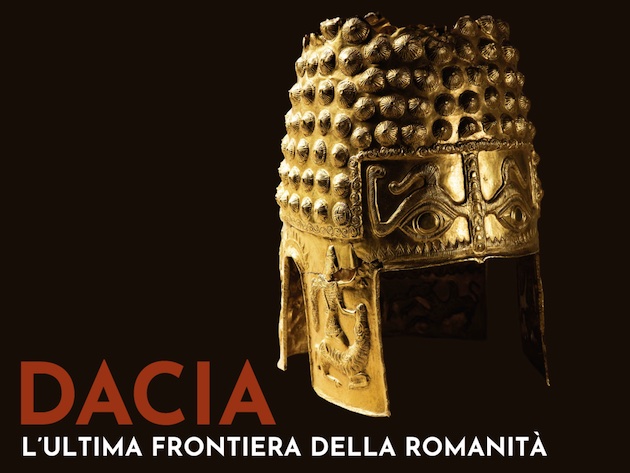
The exhibition Dacia. The last frontier of Romanity at the National Roman Museum - Diocletian’s Baths, curated by Ernest Oberlander (director of the National Museum of History of Romania), and Stéphane Verger (director of the National Roman Museum), represents the widest and most important exhibition of archaeological finds organized by Romania abroad in recent decades, to illustrate the historical and cultural development of this nation over a period of over fifteen hundred years, from the 8th century. B.C. to the 8th century. A.D.
In the rooms of the Baths, around 1000 objects from 47 Romanian museums are presented, as well as from the National Museum of History of the Republic of Moldova, exhibited for the first time together with some finds from the National Roman Museum.
The exhibition is divided into four sections: the first is dedicated to Roman Dacia and shows the conquest of the territory at the time of Emperor Trajan (101-106 AD), underlining the close connection and strong parallels between the finds from Romanian museums and those of the National Roman Museum. The second section describes the formation of the Dacian culture in the Iron Age thanks to the influence of the Thracians, the Scythians and the Greeks of the colonies on the Black Sea; the third section presents the comparison between Mediterranean urban civilizations and continental tribal and nomadic civilizations and the inclusion of Dacia in the Mediterranean and continental Hellenistic cultural networks, with new Central European populations such as the Celts, the Geto-Thracians, the Bastarnae of Germanic origin; this is also the period in which Rome begins to have political importance in the region. The fourth section focuses on the era of decline of the Empire, with the difficulties in maintaining secure borders and the threat of peoples such as the Huns, while Rome's power gradually shifted towards the East with Byzantium. This section also highlights the role of Christianization and the spread of the Latin language, fundamental elements of Rome's legacy.
The common thread of the sections is that interweaving between the two different cultures, which recurs over the centuries thanks to the abundance of resources and the key position of Romania between Europe and Asia, first with the integration of Dacia into the world Roman, then with the persistence of civilization even after the abandonment of the Dacian territory by the army and the administration of Rome, finally the coexistence of the inhabitants of the territory with the migrant populations.
Among the finds of greatest interest we point out the cast of a scene sculpted on Trajan's Column (scene XXXII, spiral V), which opens the exhibition itinerary, depicting three Dacian archers holding the Romans besieged inside a city at gunpoint and the great archaeologist Ranuccio Bianchi Bandinelli had it colored in the early 1970s, thus demonstrating the presence of color in the architecture of the Roman imperial age.
Immediately afterwards, masterpieces are exhibited such as the Glykon Serpent by Tomis, a marble depiction of a "good demon" who heals from epidemics; the wonderful gold helmet of Cotofeneşti of Thracian manufacture, with different scenes of sacrifice; the bronze Celtic helmet from Ciumeşti, with the astonishing eagle-shaped crest which is striking for the uniqueness of its workmanship; the Gothic treasure of Pietroasele from the 4th century AD. with the beautiful embossed gold phiale (cup) and large fibulae; some Dacian gold bracelets, the bronze tablets of the Lex Troesmensium and the Biertan donarium. Also on display is a selection of finds - including weapons, vases, ceramics, coins, jewels and accoutrements for magic rites - thanks to which the religion, art, craftsmanship, trade and daily life of the ancient Dacia.
The event was made possible thanks to the Embassy of Romania in Italy, in partnership with the National Museum of History of Romania and the National Roman Museum, the Romanian Ministry of Culture, the Ministry of Foreign Affairs of Romania, the Ministry of National Defense of Romania, to the Romanian Cultural Institute through the Romanian Academy, to the Italian Ministry of Culture and to the General Directorate of Museums. Placed under the High Patronage of the President of Romania and the President of the Italian Republic, the exhibition marks a double anniversary for Romanian-Italian bilateral relations: in fact, 15 years have passed since the signing of the Consolidated Strategic Partnership between Romania and Italy and 150 years since the establishment of Romania's first diplomatic agency in Italy.
Photo credits: official poster of the exhibition
Informations
Dal 21 novembre 2023 al 21 aprile 2024
Dal martedì alla domenica
ore 9.30 – 19.00
la biglietteria chiude alle 18.00
Chiuso il lunedì
Per aggiornamenti e le modalità di visita consultare il > sito ufficiale.
Programma conferenze in collaborazione con l’Accademia di Romania
I temi trattati sono connessi alle evoluzioni e alle dinamiche che hanno segnato l’Oriente e il Centro dell’Europa nel periodo dell’Antichità fino al Medioevo, momento storico che si sovrappone a quello illustrato dalla mostra sulla Dacia:
Mercoledì 22 novembre alle ore 16.00
Ernest Oberländer-Târnoveanu Direttore del Museo Nazionale di Storia della Romania “The Odyssey of the Dacian Gold Bracelets from Sarmizegetusa Regia (1999-2023)”. Introduce e modera Stéphane Verger.
Mercoledì 29 novembre alle ore 16.00
Roman bridges and bridgeheads across the Danube: Drobeta and Sucidava
Moderano e introducono Sara Colantonio e Carlotta Caruso.
 Condividi
Condividi











































